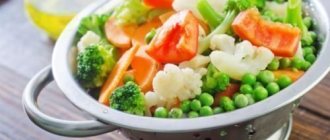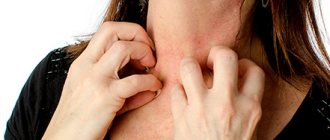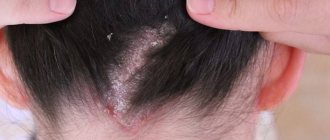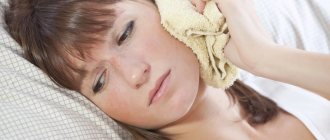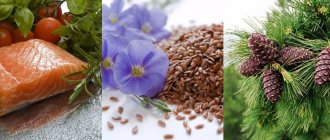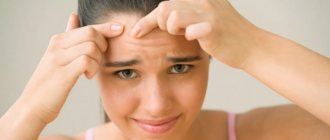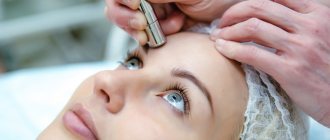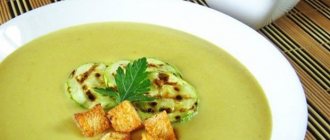Our body is an amazing mechanism, the parts of which work harmoniously. Therefore, a disease in one organ or system immediately affects others. Skin is one of the indicators that reflects the state of human health. The manifestation of a disease on the skin may be the result of a disruption in the functioning of the body. A similar disease is seborrheic dermatitis. This is a chronic skin disease that is caused by fungi of the genus Malassezia ovale when the sebaceous glands malfunction.
A little about seborrhea and its features
Skin is a reflection of the functioning of human organs, his health. When a skin disorder appears, it means that the first step is to treat the body. This is the reason why a diet is introduced for seborrheic dermatitis, which helps cleanse the body from the inside. Only a doctor can prescribe a proper diet for a patient, since not all products are approved for use for skin diseases.
Seborrheic eczema is characterized by inflammation of certain areas of the skin where there is increased production of sebaceous glands. In such patients, seasonal exacerbations of the disease are noticeable, especially in autumn and winter. In this case, doctors may prescribe skin care - washing with birch tar-based soap. Seborrhea affects different areas of the skin. This can be not only the scalp or face, but also the back, neck, and chest.
Seborrheic dermatitis is diagnosed in people of any age. The main problem of the disease is that too much sebum is produced, which is the habitat of bacteria that actively multiply and activate skin inflammation.
Allowed food
The list of permitted products is wide enough to ensure that the patient has a variety of food on his table. Even some prohibited foods can be eaten under certain conditions.
For example, you can cook porridge using an allergen product such as milk, diluting it with water (you need to take equal amounts of both).
Approved products for patients with seborrheic dermatitis:
- dairy - cottage cheese, yogurt, fermented baked milk, kefir, matsoni (they contain vitamin B, calcium, and other microelements necessary for the body);
- meat - chicken, veal, turkey, rabbit, lean pork and beef (provide the body with protein);
- sea fish and seafood, if a person does not have an individual intolerance to them - squid, mussels (fatty amino acids are needed to normalize the functions of the sebaceous glands), fish oil;
- vegetables - zucchini, different types of cabbage, including sea cabbage, pumpkin with light pulp; celery, green onions, cucumbers;
- fruits - pears, white cherries, apples (can be eaten fresh or in compote, excluding jam);
- from cereals and cereals - buckwheat, oatmeal, bran;
- from oils - olive, linseed, corn;
- jellied dishes using gelatin (accelerates skin regeneration);
- drinks - still mineral water, herbal tea (for example, chamomile), fruit juice, compote (you can use both fresh berries and dried fruits).
By the way, liquids occupy an important place in the menu of a patient with seborrheic dermatitis. In adults, the required minimum is 1.5 liters per day, and this figure can be exceeded.
Once in the stomach and intestines, water participates in the elimination of toxins. In addition, it is needed to normalize metabolism, to saturate the skin cells, which makes them elastic.
Vitamins are necessary to improve the health of the patient. If not enough of them enters the body with food, the doctor prescribes a vitamin complex to the patient.
Do I need to follow a diet?
Every day a person consumes different foods. Food is broken down into particles, some of which are useful for the body, and the other half enters the excretory system, a set of organs that remove excess water from the human body. In fact, some types of foods can encourage the formation of microorganisms and other pathogenic bacteria.
Thanks to a diet for seborrheic dermatitis, you can delicately cleanse the intestinal tract of waste and toxins and prevent harmful effects on the outer layer of the skin. Preservatives, various dyes, and chemical elements are considered unsafe for a patient who has seborrheic dermatitis, as well as for an absolutely healthy person. In other words, we can say, all products with a synthetic component.
Unnatural food can worsen the patient’s situation, so if you have the slightest problem with your skin, you should immediately consult a doctor. The doctor will conduct an examination, prescribe the necessary tests and, based on the general picture of the examination, will be able to prescribe therapy by prescribing medications and nutrition for seborrheic dermatitis of the scalp.
Features of the diet for dry seborrhea of the head
Dry seborrhea of the scalp manifests itself differently. The sebaceous glands produce a small amount of secretions. The scalp becomes dry, begins to peel, and itches. It looks very unaesthetic. Hair that was once wet becomes dry, brittle and dull. Dandruff covers the head and shoulders. If this process is not stopped, the patient will lose hair on his head due to damaged hair follicles. Following a diet will help avoid complications. The first step in treating dry seborrhea of the head is to establish nutrition and functioning of the gastrointestinal tract:
- Drink plenty of water, it adds elasticity to the skin and removes many toxins from the body.
- It is necessary to eat every 2-3 hours.
- The basis of the diet for dry seborrhea is the same - dairy cuisine, lean meats, fresh fruits, vegetables and of course porridge. Cook vegetable soups in weak meat broths. Pay great attention to rolled oats. Prepare porridge, cook soups, even cookies can be baked in the oven from this cereal.
- for dry seborrhea, the diet should be balanced and enriched with vitamins A and E. Vitamin A is found in carrots, various greens, egg yolk, and fish oil. Vitamin E is found in sufficient quantities in walnuts and peanuts.
- foods rich in sulfur and zinc should also be consumed in abundance. Zinc is an indispensable source for renewing skin cells; for the most part, it accelerates wound healing and strengthens the body's resistance. Large amounts of zinc are found in seaweed, bran and beef liver. Sulfur will help keep your nails and hair strong and shiny. It also affects bone strength. To maintain the required level of sulfur, you can eat: poultry, eggs, various seafood, as well as apples, cabbage and spinach.
Basic principles of nutrition
The key symptom of seborrhea is the intensive production of sebum, so you need to remove from the menu all products that contribute to its intensive secretion. Since allergies have a huge impact on the formation of the disease, food should be included in the menu, which makes it possible to reduce the allergenic load on the body.
It is important to consider the method of preparing food, because food for seborrheic dermatitis should not only be healthy, but also steamed. Why is this so? With the steaming technology, food will preserve the necessary elements, especially when cooking meat and vegetables. This kind of diet for skin diseases involves a gentle effect on the organs of the digestive system.
You can bake foods by wrapping them in foil. This type of food preparation and diet for seborrheic dermatitis on the face is used quite often. Food must be treated with boiling water for at least 15 minutes. Nutrition for seborrheic dermatitis of the scalp takes into account the daily consumption of vegetable dishes with the least processing to preserve the necessary elements.
The diet for seborrheic dermatitis is selected taking into account the characteristics of the body and its reactions to various foods. Nutrition for seborrheic dermatitis for people who are exposed to systematic force loads should be different.
Based on the results of studies conducted in medical institutions, it was proven that the diet for seborrheic dermatitis on the head must contain natural immunostimulants. Doctors often prescribe medications to improve gastrointestinal functions and medications aimed at treating long-term illnesses. The dermatologist will prescribe a course of drug therapy, so you need to adhere to the specified dosage.
What products can be included in the menu for seborrhea?
Most people, having learned that food should be steamed, immediately begin to think about what can be steamed and whether such food will be edible. However, for those who have dermatological problems do not have to worry, because there are a lot of dishes for daily use. A diet for seborrheic dermatitis of the scalp and face will help not only eliminate the disease, but also cleanse it of harmful accumulations and provide it with useful vitamins. Food prepared by boiling is also useful both steamed and baked.
When a person is diagnosed with seborrheic dermatitis, the diet must be followed every day so that all efforts are not in vain. After all, the condition of the scalp depends on a proper diet.
Let's look at the foods that are included in the healthy diet:
- Dietary meat. Of course, the meat must be dietary, so chicken breast and beef will do, but pork is not recommended. It is strictly forbidden to fry rabbit meat. In this case, the meat needs to be baked in the oven.
- Fish. It is also permissible to use not very fatty types. If you are a seafood lover, you should consult your doctor before eating them.
- Vegetables should be in the diet of a healthy person. You can add pumpkin to the menu, even if you haven’t eaten it before. Pumpkin helps improve the functioning of the digestive tract and is useful for seborrhea.
- Berries can only be used fresh, and not prepared as jam or waiting. It is useful to drink compotes from cherries, currants, and cranberries.
- Fruits. The healthiest fruits are apples and kiwis.
- Olive oil is very healthy, so you can add it to salads.
- Dairy food products.
- Porridges are especially useful with milk. As for semolina, it should not be consumed.
- If you are not allergic to nuts, you can safely eat them every day. They are rich in B vitamins to restore the functions of the digestive and nervous system.
- It is necessary to observe the correct drinking regime, that is, drink up to two and a half liters of liquid daily.
In the treatment of skin problems such as seborrheic dermatitis, the main thing is not to forget about the foods that need to be removed from food. Let's look at what you shouldn't eat if you have seborrheic dermatitis:
- Carbohydrates are instantly absorbed:
- baked goods;
- sweets;
- jam;
- confectionery.
- Smoked food, pickling foods, and spicy foods are also harmful. Often, when cooking, a lot of salt and seasonings are added, which stimulate disturbances in the activity of the liver, intestinal tract and other organs.
- Avoid fast food. There is nothing worse than this kind of food, since there are no useful elements in this food.
- Quit smoking and drinking alcohol. Naturally, bad habits are harmful for every person, however, for people prone to the problem of skin diseases in particular.
- Fried food is very harmful directly due to the large number of carcinogenic elements that arise during cooking.
- Any food that causes allergies. These include the following:
- citruses;
- berries of rich bright colors. The list of berries includes not only oranges and tangerines, but red berries, especially raspberries and strawberries, can cause allergies, and it is also not recommended to eat papaya and mango;
- mushrooms;
- bee products;
- nuts.
Doctors have found that problems with skin diseases often occur in people who cannot give up confectionery products and canned food. Also, most of the patients eat flour every day, for example potatoes, pasta, which also refers to food that is quickly digested. Therefore, if possible, avoid flour.
Dietary guidelines for seborrheic dermatitis
With the help of a diet, two main problems are solved: an allergen product is excluded from the menu and (due to the competent selection of products) the load on the digestive organs, which could provoke the development of various inflammations in the body, is reduced.
Here are a number of rules on the basis of which the menu of a person suffering from seborrheic dermatitis is formed:
- products containing preservatives (for example, fast food items) are prohibited;
- exclude from the menu not only “their” allergen, but also other products that usually cause an allergic reaction in most patients and burden the patient’s immune system with additional work (for example, nuts, honey);
- approach carbohydrates with caution, since their excess in the body is favorable for the proliferation of fungal infections;
- limit a person’s consumption of spices, because they reduce the number of beneficial bacteria, and this shortage primarily affects the condition of the skin of the scalp;
- do not drink alcohol (not only strong drinks, but also beer);
- include fresh (seasonal) fruits and vegetables in the menu, enriching it with vitamins;
- do not use a mono-diet, so as not to leave the body without any important microelements;
- select the optimal heat treatment option.
If a patient has seborrheic eczema, it is important to reduce the activity of the sebaceous glands. This can be achieved by removing fatty, smoked, and spicy foods from the table.
Seborrheic psoriasis (it is observed not only on the head, but also on the arms and legs) prohibits the consumption of coffee and even strong tea.
If an infant has seborrhea, the nursing mother must adhere to a strict diet so that substances that can aggravate his condition do not enter the body with her milk.
What a sample menu should look like
Throughout the day you need to eat up to six times, in small portions. It is thanks to this method of nutrition that you can maintain youth and health.
Created menu for every day No. 1
- In the morning - boiled egg, oatmeal.
- Snack: nuts + jelly.
- Lunch - boiled chicken breast, vegetables (preferably cabbage).
- Snack - a glass of yogurt or kefir.
- Dinner - fish with vegetables, not very fatty types.
Created menu for every day No. 2
- Breakfast - pearl barley, pear.
- Snack - 250 ml of kefir.
- Lunch - beef boiled with vegetable salad in olive oil.
- Snack: fermented milk products, especially cottage cheese.
- Dinner - mackerel, cooked in the oven with vegetables.
Since seborrheic dermatitis intensifies with an allergic reaction to foods, diet is the basis of therapy. After taking medications and dietary nutrition, each patient will be able to notice a positive result within a month. Please note that dietary nutrition must be followed during the period of exacerbation of the disease (autumn - winter). Diet for seborrheic dermatitis, a balanced menu is extremely useful for the functioning of all organs. When treatment is prescribed by a qualified doctor, the result will be healthy and clean skin.
Traditional methods of treating seborrhea
The method of treating seborrheic dermatitis with folk remedies depends on the form of the disease.
Recipes for oily seborrhea:
- Oak bark. 1 tbsp. l. dry bark, pour 500 ml of water, boil for 15 minutes and leave to infuse for half an hour under the lid.
- Burdock. 2 tbsp. l. Pour a glass of boiling water over the dried ground root, leave for 1 hour, then strain.
- Aloe. Squeeze the juice from aloe leaves and combine with alcohol in a ratio of 1:5.
For dry seborrhea:
- Sea buckthorn. Crush 1 tbsp. l. berries, combine with 6. tbsp. olive oil and heat, diluting with freshly squeezed sea buckthorn juice, until the composition turns orange. Apply to skin 1 time every 3 days for 1 month. If necessary, repeat the course.
- Tansy. 2 tbsp. l. Grind dried tansy flowers to a powder and brew with a glass of boiling water. Leave for 30 minutes, then apply to the skin with massage movements. After 40 minutes, wash off.
- Meadowsweet six-petalled. Pour boiling water over 100 g of rhizomes and leave for 5 hours. Rinse your hair with the resulting infusion after washing 3 times a week. The course consists of 15 procedures.
The resulting compositions must be applied daily to the affected areas for 3 months. You can rinse your hair with herbal decoctions after washing.
Proper nutrition is an important part of treating seborrhea. Even after recovery, you should not abuse prohibited foods, especially in the first 1-2 months. This will help avoid relapses.
- about the author
- VK profile
What vitamins are needed to treat dermatitis?
An important circumstance in the occurrence of seborrheic dermatitis is considered to be a condition of the body that is caused by a decrease in the amount of one or more vitamins in the body. Moreover, the disease progresses even more against the background of a hypoallergenic diet, which excludes the consumption of many fruits and vegetables. Therefore, the main task is to compensate for the lack of vitamins with products that already contain a complex of vitamins.
The main vitamins for seborrheic dermatitis belong to the group A, B, PP, E. The doctor usually prescribes a vitamin-mineral complex, for example, Vitrum. However, they are suitable solely as a disease prevention. Do not forget that vitamins should only be prescribed by a doctor, since different vitamin complexes are prescribed for different manifestations of seborrheic dermatitis.
It is important to keep in mind that nutrition can bring not only benefits, but also harm to the patient if the symptoms of the disease are observed simultaneously on the scalp and face. It must be borne in mind that nutrition for seborrheic dermatitis is not so strict, since it is necessary to remove foods from the menu that are potential aggressors. Before changing your daily diet, you need to consult a dermatologist and, if necessary, undergo an examination.
Remember, there are no special professional measures that could prevent the occurrence of seborrhea. But those who eat right, spend time in the fresh air and lead a healthy lifestyle, excluding tobacco and alcohol, are less likely to get sick. So, ensure proper care of the scalp and face, harden the body, and also promptly treat infectious diseases. Your health is only in your hands!
